
ABSTRACT
Despite a decline in investment in the upstream oil and gas sector, the downstream industry has maintained production, and investment has been sustained refineries and the petrochemical, chemicals, and mining sectors, presenting a potential area for the application of reliability studies.
Reliability management can be implemented through a four-stage cycle: define, plan, act and feedback. The Define phase consists of establishing the strategy, defining objectives, goals and key performance indicators, and developing reliability and integrity plans. During the Plan phase, data is collected, evaluated, mapped, and gaps are assessed. In the Act phase reliability and integrity analyses are performed. The Feedback phase aims to make improvements. A case study describes how a reliability, availability and maintainability study was undertaken in a real refinery.
New investments in the oil and gas (O&G) upstream sector have greatly declined in the last couple of years but the downstream industry nonetheless maintained its production. The decline was mainly caused by global factors related to shale gas, environmental restrictions, and the Chinese economy, combined with decisions taken by OPEC countries and Russia. Though the upstream sector shrank, lower crude oil prices were beneficial to its consumers downstream. Consequently, investment has been sustained in refineries and the petrochemical, chemicals, and mining sectors, presenting a potential area for the application of reliability studies.
Reliability management can be implemented through a four-stage cycle: define, plan, act and feedback, as presented in Figure 1. The Define phase consists of establishing the strategy, defining objectives, goals and key performance indicators (KPI) and developing reliability and integrity plans. Next, during the Plan phase, data is collected, evaluated, mapped, and gaps are assessed. In the Act phase the different reliability and integrity analyses are performed, such as failure mode, effects and criticality analysis (FMECA), reliability, availability and maintainability (RAM) study, risk based inspection (RBI), reliability-centred maintenance (RCM), and so on. The Feedback phase aims to make improvements that can be implemented by means of audits and training. Throughout the process, reliability software and training provide the necessary support.
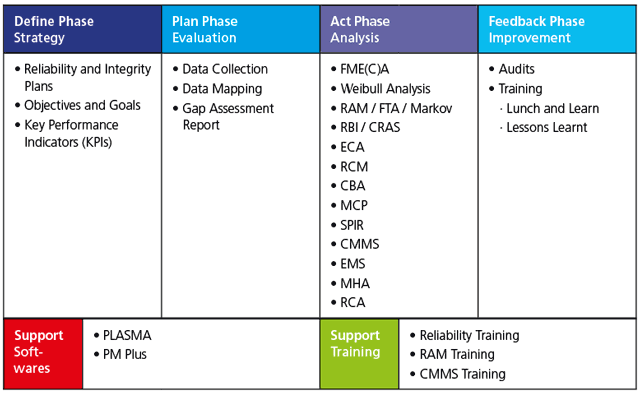
The complexity of reliability studies varies according to the project engineering phase, as shown in Figure 2. From concept to operation, the level of detail of the statement of work (SoW) increases.
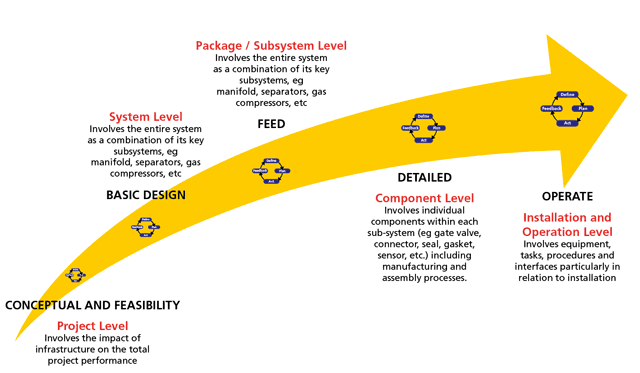
To address the different levels of complexity, the use of software may be necessary. Information from the client’s existing database, such as computerised maintenance management systems (CMMS), is exported and processed using the selected software, as presented in Figure 3.
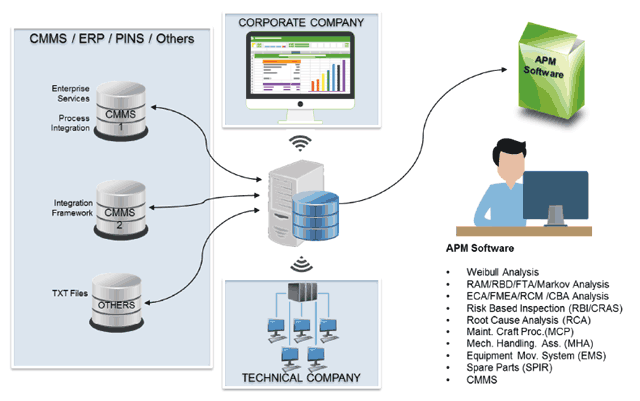
Reliability issues
During the development of the reliability study, different complications may arise due to various factors. Some of them are listed as follows:
- Lack of reliability culture/program
- Inconsistent reliability data
- No integration between the reliability studies
- Maintenance/reliability engineer overburdened with too many tasks
- Reliability software complexity
- Misuse of equipment
- Location of the suppliers
- Design not taking into consideration all operating/environmental conditions
- New technologies
- Excessive quantities, or a lack of, spares.
Other common situations include problems with organisational requirements, such as work permit delays, insufficient training or supervision, unclear procedures, multi-cultural teams, use of inadequate tools, and the like.
Case Study: RAM Study
A refinery installed a new gas train, identical to the existing facilities, to increase the production of methane, ethane, propane, and other hydrocarbon derivatives. The facility included pre-treatment, recovery, and fractionation mainly.
A RAM model was developed to forecast the production of each relevant product. The reliability performance of unspared and 2×50% compressors (that is, in case of one compressor outage the production would be reduced by 50%) were assessed in detail. Critical submersible pumps in the drainage area were identified as having maintainability challenges and were thoroughly assessed. Issues with the external supplies (for example, chemicals such as methanol, sea water supply) were identified and quantified. After identifying bottlenecks, recommendations achieved a potential production gain of approximately 3%. These main issues were further investigated as described below.
Weibull analysis
A Weibull analysis was performed to measure and compare reliability between three different suppliers. Different sets of compressor reliability data (example provided in Table 1) were provided for detailed examination. The operational requirement was a mean time to failure (MTTF) of at least 100,000 hours.
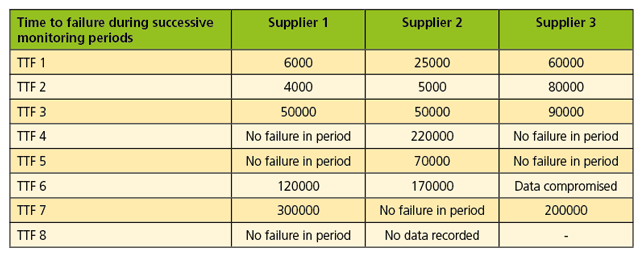
The curve parameters (shape factor β and life characteristic factor η) for each supplier 1, 2 and 3 was calculated. All suppliers had a similar life characteristic factor of approximately 100,000 hours. However, each supplier had a different shape factor, respectively β1, β2 and β3.
The reliability curves were plotted and the reliability at 100,000 hours was calculated: The reliability value (%) corresponds to the probability of each compressor surviving 100,000 hours operating under certain conditions. The results are summarised in Table 2.

The results showed that although all compressors complied with the MTTF of approximately 100,000 hours, their reliability varied. The third supplier presented compressors which had the highest probability of achieving the desired lifetime of 100,000 hours. On the other hand, the first supplier’s compressors were likely to fail earlier.
When assessing the maintainability factor, all the three compressors had similar maintenance downtime: therefore the decision could be made based on the reliability and cost factor.
Maintainability Review
During the RAM study, it was found that long repair times were associated with two submersible pumps used to drain a main closed drain vessel. This was due to difficulties in performing maintenance, resulting in the activity being performed only when both submersible pumps had failed.
RCM studies were reviewed and the maintenance tasks were specified in the maintenance craft procedure (MCP) to assist maintainers to perform their tasks. Troubleshooting to address specific pump faults was also implemented.
To support even further, a material handling assessment (MHA), equipment moveable systems (EMS), and spare parts interchangeability record (SPIR) were developed to support the maintenance task activity
Preventive maintenance interval based on cost
In order to define the optimum maintenance effort, a cost benefit analysis was performed. The maintenance frequency was determined using a maintainability curve (Figure 4).
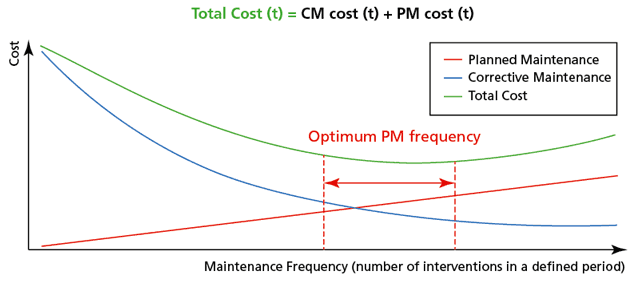
Total costs included planned and corrective maintenance expenses.
Computerised maintenance management system review
The CMMS maintenance records were assessed to identify gaps, that is: identify issues related to the historical maintenance records, work order requests and work order releases and evaluate the use of the CMMS, the maintenance system in place, the planning, reliability users’ feedback, and so on.
Results included recommendations to update the CMMS layout, data entry method (breakdown of downtime, opportunistic maintenance), inspection data (intervals, type and results of each inspection), etc. The schematic in Figure 5 is a typical plant maintenance engineering software process.
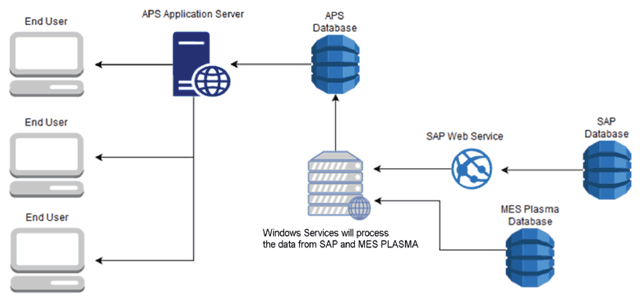
Conclusion
There are many reliability studies that can be applied and normally these studies are applied independently from each other. For example, a RAM analysis is performed based on reliability and maintainability data collected from data libraries and in very few occasions the failure mode and maintenance tasks are taken into consideration. The outcome of these studies can reflect the benchmark industry values; however, they might not reflect the real operating state of the facility. Therefore, the recommendations generated from certain studies might be biased.
The integration of all the reliability studies certainly will maximise the benefit of the application of each individual study – for example, the maintenance data collected from the CMMS database can be thoroughly assessed and each equipment reliability and maintainability curve obtained. The curve parameters combined with the maintenance tasks obtained from the RCM study, which will assess in detail each failure mode and its effects, can be used as input to the RAM Study and the outcome will truly reflect the operational state of the plant. In this scenario, the optimisation recommended by the study will certainly reflect the expected outcome of the facility.


